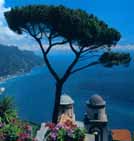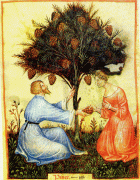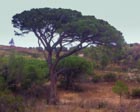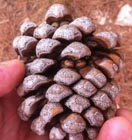Conservation Status

Pinus pinea
Linnaeus 1753, p. 1000
Common names
Pinheiro manso [Portuguese]; pino piñonero, pino manso, pino doncel, pino albar [Spanish]; pin parasol, pin pignon [French]; pi pinyer, pi pinyoner, pi para-sol, pi bo, pi ver [Catalan]; Pinu granatu [Corsican]; pino domestico [Italian]; κουκουναριά [Greek]; pinija [Serbian]; Fıstık çamı [Turkish]; אורן הצנובר [Hebrew]; صنوبر ثمري [Arabic]; Italian stone pine, stone pine, Mediterranean stone pine, umbrella pine.
Taxonomic notes
A very distinct pine, placed in Sect. Pinea, subsect. Pineae, in which it is the only species; the section also includes subsect. Pinaster, which has similar foliage but very different cones (see e.g. P. pinaster, P. canariensis, P. brutia).
Description
A tree 12-25(35) m tall, trunk often short and commonly slightly sinuous. Crown highly distinctive (shape shared only by P. nelsonii of NE Mexico), globose and shrubby when young, later domed and becoming very broad low-rounded with age; not conic except in first two years from seed; with long branches rising at 30°-60° above horizontal; branch tips upswept to vertical. Bark thick, plated, deeply fissured, red-brown to orange with blackish edges to the plates. Shoots usually uninodal, very rarely multinodal on vigorous young trees; moderately stout, yellow-buff, rough with persistent decurrent scale-leaf bases. Buds ovoid-acute, 7-20 mm, with red-brown scales with long free tips revolute and fringed with white hairs. Adult leaves mid-green, retained for 2-4 years, with a persistent 1-1.5 cm sheath, in fascicles of two, 10-18(28) cm long, about 1.5 mm thick, with serrulate margins and fine lines of stomata on both faces. The juvenile leaves are glaucous, 1.5-4cm long, and continue to be grown for 3-10 years, mixed with the first adult leaves from the third year. Cones on short stout stalks, symmetrical, broad ovoid to globose, 8-12(15) cm long, 5-11(12) cm broad when closed, resembling a children's comic idea of a hand-grenade (!); green, ripening shiny chestnut-brown in April three years after pollination (the longest maturation period of any pine). The scales are broad, thick, woody, very stiff; the apophysis is bulbous, 15-20 × 15-20 mm, smoothly rounded; due to the three-year maturation, the dorsal grey-buff umbo is double, with an inner umbo (first year's growth) and a concentric outer umbo (second year); the inner umbo has a very short stout reflexed mucro. The seeds are pale brown thickly covered with a black soot-like powder, 15-20 × 10 mm with a loosely attached vestigial 3-8 mm yellow-buff wing. The cones open on ripening or up to a year later, invariably shedding all the infertile basal scales to allow the fertile scales to open more widely; the large seeds are dispersed by birds, mainly Cyanopica cyanus (azure-winged magpie), and in the last 6,000+ years, by humans, which has considerably extended the pine's distribution (description prepared by Michael Frankis 1999). See García Esteban et al. (2004) for a detailed characterization of the wood anatomy.
Distribution and Ecology
Albania, Algeria, Croatia, Cyprus, France (incl. Corsica), Greece, Israel, Italy, Lebanon, Montenegro, Portugal, Slovenia, Spain (incl. Canary Islands), Syria, and Turkey. Prior to the anthropogenic range expansions of the last few thousand years stone pine was probably confined to the Iberian Peninsula, the only area where it is found away from ancient trade routes (Rikli 1943). It is said to be "impossible to determine its natural range" (Barbéro et al., in Richardson 1998). The species is an archaeophyte (unrecorded introductions by early man) throughout the Mediterranean, and more recently has been naturalised in South Africa (Cape prov.) and in other regions with Mediterranean climates, such as California (Rikli 1943, Richardson 1998, PLANTS database 2009.03.31).
Distribution of the Mediterranean species of subsect. Pinaster. Polygons provided by Caudullo et al. (2024). P. pinea shown in magenta. Click on any polygon to see the species represented.
P. pinea thrives in coastal sandy areas with moist but well-drained soils and little temperature variation. It is sensitive to environmental disturbance and difficult to regenerate (Moussouris and Regato 1999). Hardy to Zone 8 (cold hardiness limit between -12.1°C and -6.7°C) (Bannister and Neuner 2001).
Remarkable Specimens
The largest recorded in Italy is 35 m tall with a dbh of 204 cm; it is in Scuto, Calabria, Delianuova, RC (Corpo Forestale della Stato 2004).
Natalini et al. (2016) developed a tree-ring chronology in Spain, presumably based on live material, covering 228 years; if this record was from a living tree, it would be the oldest I have seen documented.
Ethnobotany
"The total area covered by stone pine woodlands is 380.000 ha (75% in Spain, 9% in Portugal, 9% in Turkey, 5% in Italy, and lower percentages in Greece, Lebanon and France. Stone pine woodlands ... management renders a variety of products such as: nuts, wood, firewood, resins, bark, pastures/livestock, hunting, honey... Stone pine kernels are used in the Mediterranean as a culinary delicacy and have a protein value two thirds that of lean steak" (Moussouris and Regato 1999).
The first pine used and cultivated by man, its edible seeds have been harvested for perhaps half a million years or more, and the tree planted for them for well over 6,000 years (possibly double this or more); it was introduced from Spain to as far east as Israel and Georgia on the Black Sea coast long before historical records were kept. "[S]eeds of this pine have been used as food by humans since prehistoric times and were widely traded" (Barbéro et al., in Richardson 1998). Theophrastus (c.372-287 BC) recorded it as 'domestic pine.'
Colin Wallace, in an unpublished manuscript, shows that written records document the economic and spiritual importance of this species in the Classical world: "A Graeco-Roman papyrus of the second century AD records sixteen pine cones (stobeilon) among the multiples of items like cakes and palm-branches, supplied to a district governor for sacrifice to the river-god Nilos (Bowman 1986, 183/Sel Pap II no 403: source P Oxrhyncus 1211). The monthly account of a temple of Iupiter Capitolinus at Arsinoë mentions spending 12 drachmae 'for pine-cones and spices and other things' on the occasion of the visit of the prefect in AD 215 (Sel Pap II no 404: source Berliner Griechische Urkunden 362) and a dealer in pine-cones (a stobilas) appears in another C2/C3 source (P. Oxyrhyncus 1446). This view of pine kernels as a luxury item is upheld in the recent listing of plant remains from early Roman Mons Claudianus (van der Veen 1998, 105/107); they are likely to have been imported into Egypt (from the Levant?) at all periods (Serpico 2000, 432-33)."
Research into dating of seed shells in prehistoric archaeological sites would be valuable in helping to determine the anthropogenic spread of the species, but does not appear to have been carried out to any extent. It is still extensively cultivated throughout the Mediterranean area. The richly flavoured seeds are essential for many Portugese, Spanish and Italian recipes.
The following long quote is from Moussouris and Regato (1999):
In addition to its nutritional value, stone pine nuts have been considered as an aphrodisiac all around the Mediterranean since ancient times. The Roman poet Ovid (born in the 1st century BC) in his Ars amatoria - The Art of Love , a poem that challenged the serious moral reform efforts of Augustus, provides a list of aphrodisiacs including 'the nuts that the sharp-leafed pine brings forth.' The Greek physician Galenos, of the 2nd century AD, suggests that a mixture of pine seeds, honey and almonds taken before bedtime for three consecutive evenings can increase sexual potency. Apicius, a Roman celebrity who loved good food and his recipes (such as walnut stuffed dormouse) were used up to the Middle Ages, recommends a mixture of pine nuts, cooked onions, white mustard and pepper to achieve the same thing. Finally, the Arab Perfumed Garden referring to Galenos' writings advises that in order to achieve sexual vigour a man should eat 20 almonds and 100 pine nuts accompanied by a glassful of thick honey for three nights before bedtime.
Spain has the most organised pine nut production among Mediterranean countries. The production varies in cycles of 2-6 years. The number of pinecones per tree is a function of tree diameter and the average yield is about 15-22 kg of pine nuts per 100 kg of cones. Collection takes place by men who climb on trees and gather the cones by hand or with a special tool. Each worker can collect about 400 to 600 cones per day. The collection period is from November to February. Extraction of the nut takes place by drying the cones in the sun. Empty cones can also be used as firewood. Before reaching the market the external hard cover of the pine seeds is removed by the use of special machines, a process that adds extra cost to the product.
The average annual production of Spain is about 6.250 tones/yr. and represents 40 to 60% of world production of pine nuts (including the nuts coming from other pine species). Most of the production is exported, mainly to the USA through Italy.
The timber is used occasionally, but the trees are normally preserved for their value as a food source.
The species has been used for dendrochronology, e.g. Akkemik (2000) used it for a dendroclimatic study.
Observations
Stone pine is abundant in S Portugal and the adjoining Marismas area of the Guadalquivir River basin in SW Spain, where it forms extensive forests.
I would like to see the Strofilia (Greek for "stone pine") forest in south-western Greece. It comprises 80% of the remaining stone pine forest in Greece. Located in the western Peloponnese, the forest covers a north-south coastal strip with a length of 15 km and an average width of 1.5 km. Pinus halepensis and Quercus aegilops are other important tree species to the Strofilia forest structure. The management - or rather, mismanagement - of this forest is decribed by Moussouris and Regato (1999).
Remarks
The epithet pinea means "piney", so this is literally the piney pine.
A famous tree at Ravello near Napoli in Italy can be seen photographed in virtually every European holiday brochure!
The final scene in the 1951 Vittorio de Sica film "Umberto D." takes place in an urban park planted with P. pinea.
Citations
Akkemik, Ü. 2000. Dendroclimatology of umbrella pine (Pinus pinea L.) in Istanbul, Turkey. Tree-Ring Bulletin 56:17-20.
Bowman, A. 1986. Egypt after the Pharoahs. London: British Museum Publications.
Corpo Forestale della Stato. 2004. Alberi Monumentali D'Italia. http://www.corpoforestale.it/foreste&forestale/ricerca&progetti/alberi_m/index.htm, accessed 2009.04.27.
Natalini, F., Alejano, R., Vázquez-Piqué, J., et al. 2016. Spatiotemporal variability of stone pine (Pinus pinea L.) growth response to climate across the Iberian Peninsula. Dendrochronologia 40:72–84. https://doi.org/10.1016/j.dendro.2016.07.001.
Rikli, M.A. 1943. Das Pflanzenkleid der Mittelmeerländer (cited in Mirov 1967).
Santesson, Johan. 2000. Pine nuts as aphrodisiacs. http://www.santesson.com/aphrodis/pine.htm, now defunct.
Serpico, M. 2000. 'Resins, amber and bitumen', pp. 430-474 in Nicholson, P.T. and Shaw, I. (eds.) Ancient Egyptian Materials and Technology. Cambridge.
Veen, M. van der. 1998. 'A life of luxury in the desert? The food and fodder supply to Mons Claudianus', Journal of Roman Archaeology 11: 101-116.
This page was initially compiled by Michael Frankis, 1999.01.27.
See also
Elwes and Henry 1906-1913 at the Biodiversity Heritage Library. This series of volumes, privately printed, provides some of the most engaging descriptions of conifers ever published. Although they only treat species cultivated in the U.K. and Ireland, and the taxonomy is a bit dated, still these accounts are thorough, treating such topics as species description, range, varieties, exceptionally old or tall specimens, remarkable trees, and cultivation. Despite being over a century old, they are generally accurate, and are illustrated with some remarkable photographs and lithographs.





